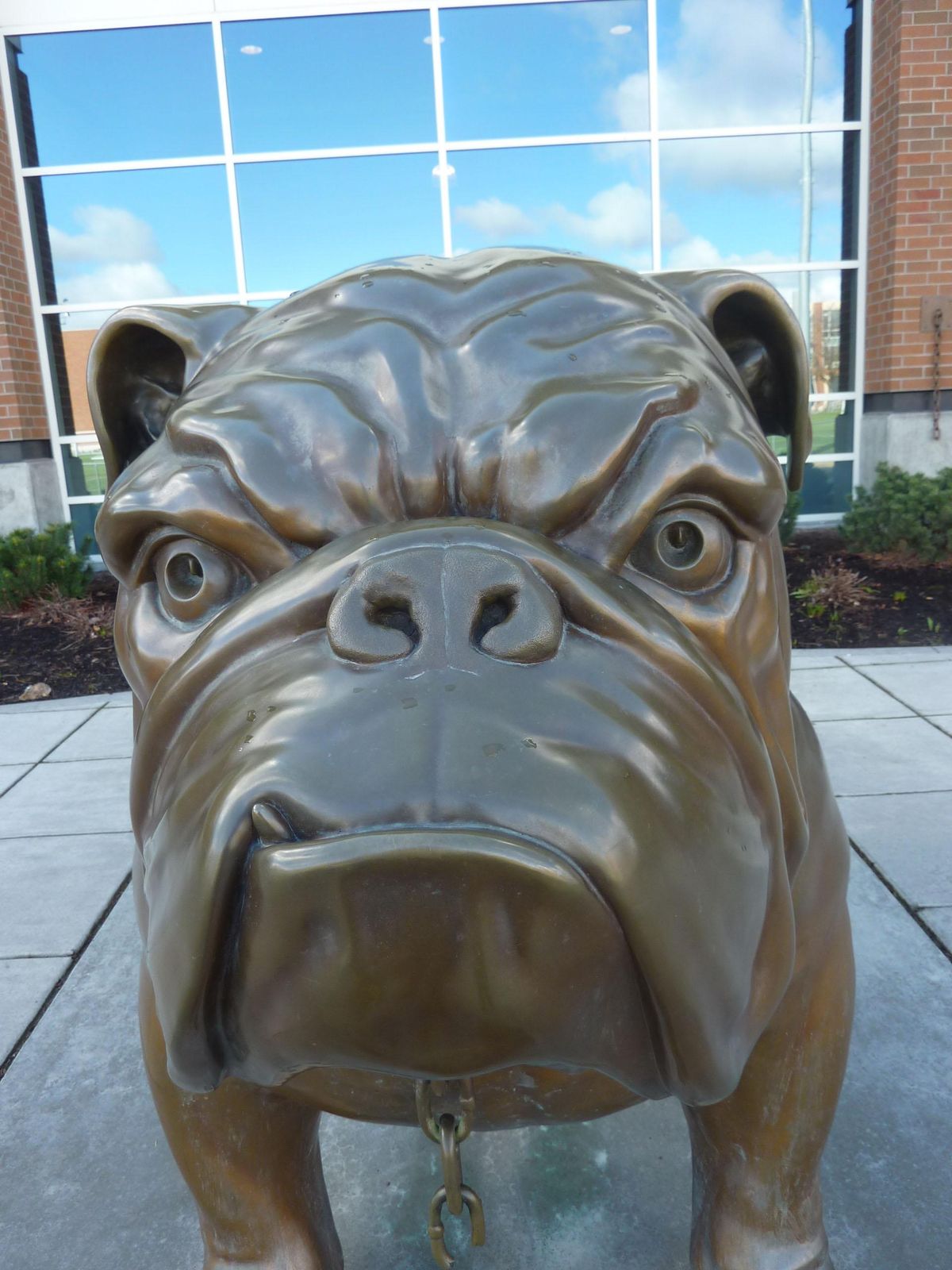Bulldog sculpture at Gonzaga’s arena modeled after King Kong

What do the bronze bulldog sculpture outside the McCarthey Athletic Center at Gonzaga University and King Kong have in common? More than you might think.
The 5-foot-tall bulldog has guarded the Kennel Club – or student – entrance to the arena where the Gonzaga Bulldogs have played their brand of winning basketball since Oct. 6, 2007, and, in the short time since, has already become a landmark for students and visitors alike. “It is the iconic place to take a picture on campus,” said Todd Zeidler, director of communications/sports information director with Gonzaga Athletics.
How the bulldog sculpture came to be is a story already told – as a gift from the graduating class of 2006. But the King Kong chapter of the story is not so well-known.
Local artist Vincent De Felice, who specializes in works of bronze, was approached by the university to design the bulldog for the student gift. “The initial discussions were for a life-sized bulldog, which is what the class had the money to pay for,” De Felice said, “but it became clear right away that a life-sized bulldog would be lost next to such a large building. It would be almost a tripping hazard.”
Clearly, the bulldog needed to be larger than life, “an icon you can engage with eye to eye, standing guard at the kennel,” he said, “so when you walk up to it, you can look directly into its eyes.”
The upsizing significantly increased the cost of the project, so several community benefactors stepped in with financial help. A committee got together to discuss what it wanted the bulldog to convey – not too passive, not too aggressive, strong but welcoming and also whether the sculpture should be standing or sitting, on a base or on the ground. DeFelice began his research.
“That was part of the art of it,” he said, “picking how it should look. How hard could that be?”
Turns out, hard. De Felice said he examined established standards for what makes good bulldog conformation and balanced that with what the average person thinks a bulldog looks like. He also had to emulate the illustrative or cartoon style of bulldogs, a process that took four months.
In his research, he learned the designers of the King Kong image determined that if they just upsized a regular gorilla, it wouldn’t quite have the soul or character to portray what they wanted for their movie. So they re-engineered gorilla features. What they did, DeFelice said, was look at bulldogs and add some doglike features to the face of their King Kong for just the right expression.
Following that thinking in reverse, De Felice studied the facial structure and expressions of gorillas, and included some of those to add character to the bulldog face – in some of the stiffness and protrusion of the lower jaw, the exaggerated bottom lip as it wraps around one protruding tooth and a bit around the eyes, nose and mouth. It’s subtle, he said, but it brings out more of the personality that is associated with bulldogs.
DeFelice did the original sculpture out of water-based clay like that used for ceramics. It was so heavy that it could not be moved safely, so the people who would make the mold for casting in bronze came from the foundry in Oregon to do it here.
When the bulldog – officially titled “It’s Our House” – was installed, De Felice said the more than 1,000-pound work of art was set in place on the ground. “If it were on a pedestal, that would make it less approachable,” he added. It is affixed with what he described as four beefy stainless steel rods welded under the pads of the feet and set 18 inches into the concrete pad below. There is a collar on the bulldog with a broken chain hanging from it – and on the building behind it, the remainder of the chain is attached.
“The broken chain shows independence,” De Felice said, “but the bulldog remains loyal and protective, staying near his house, on guard.”
The decision was made to place the sculpture on the north side of the McCarthey Athletic Center, not by the major public entrance on the south side. It was always important to keep it at the student entrance since it was a gift from the students, but “people can and do easily walk up to it and stop by to rub the tooth, nose or ears,” said De Felice, who has other works at the university as well – a statue of Father Desmet near College Hall, a crucifix and stained glass window in the law school chapel, and the 9-foot-long, 3-D relief of the Gonzaga coat of arms on the Crosby Student Center. Some of his other well-known works in Spokane are the statue of Joe Fan at Joe Albi Stadium and the bronze of Louis Davenport on a bench off the lobby of the Davenport Hotel downtown.
There’s an interesting footnote to the story. “I hear from people how their real dogs react, and I get phone videos from them,” DeFelice said. “Their dogs bark or growl or get very passive when they see the bulldog. They interact with it just as they would with a real dog.”
And that, he said, “is the best compliment I could get.”